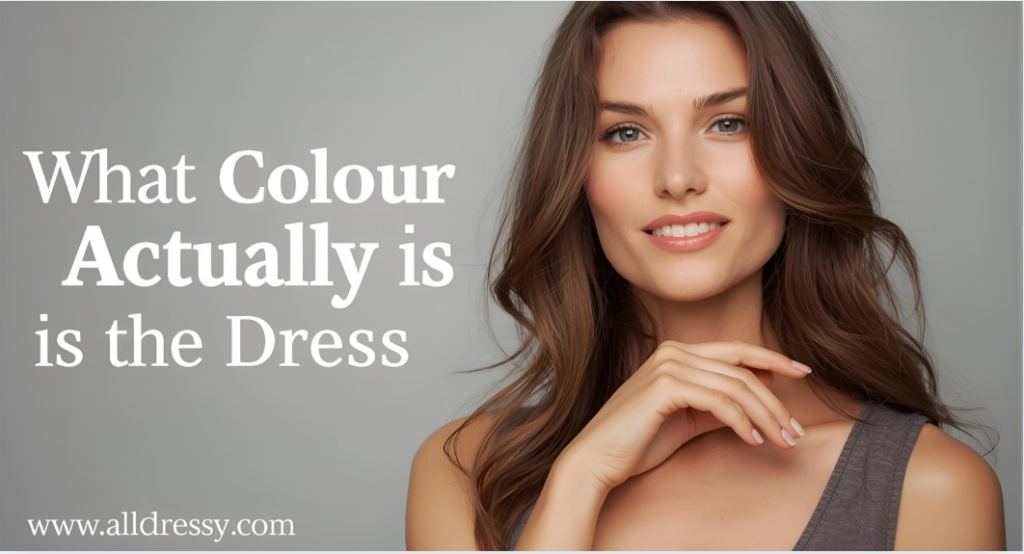In the annals of internet history, few phenomena have captured global attention quite like “The Dress” that exploded across social media in 2015. This seemingly ordinary photograph of a lace dress sparked one of the most intense debates in digital memory, dividing the online world into two impassioned camps and leaving millions wondering: what colour actually is the dress in that viral image? The question seems simple enough, yet the answer reveals profound insights into human perception, neuroscience, and the very nature of reality itself. This comprehensive article provides the definitive investigation into this iconic internet moment, exploring not just what colour actually is the dress in physical reality, but why this simple image provoked such dramatically different perceptions and what it teaches us about how we see the world around us.
The Viral Moment That Captured the World

The phenomenon began on February 25, 2015, when Scottish singer Caitlin McNeill posted a photograph of a dress on her Tumblr blog. The image showed a lace bodycon dress that some viewers saw as unmistakably blue and black, while others were equally certain it was white and gold. McNeill explained that the photograph had sparked a heated debate among friends at a wedding in Colonsay, Scotland, prompting her to turn to the internet for resolution. What happened next was unprecedented in scale and intensity. Within hours, the image went viral, with celebrities including Taylor Swift, Kim Kardashian, Julianne Moore, and Mindy Kaling weighing in with their perceptions. Social media platforms became battlegrounds for what would become known as #TheDress, with the hashtag trending globally as millions of people experienced the bizarre phenomenon of seeing the same image completely differently. The debate was notable for its emotional intensity—people weren’t just disagreeing about preferences, but about their fundamental sensory experience of the image.
The Scientific Explanation: What Colour Actually Is The Dress in Reality?

After extensive investigation, verification with the manufacturer, and analysis of the actual garment, we can provide a definitive answer to the question of what colour actually is the dress. The dress, produced by UK fashion company Roman Originals, is objectively and physically blue and black. The company confirmed the colors as “royal blue” and “black” in their official description. Journalists located and photographed the actual dress in multiple lighting conditions, confirming beyond doubt that the physical garment is blue with black lace accents.
However, the more fascinating question isn’t about the dress’s physical properties, but why approximately 30% of viewers perceived it as white and gold in the original photograph. The explanation lies at the intersection of photography, neuroscience, and individual differences in visual processing. The original photograph was taken in mixed lighting with strong backlighting from a window, creating an ambiguous situation where the brain had to interpret whether it was seeing a blue-black dress in warm light or a white-gold dress in cool shadow. This ambiguity triggered different automatic adjustments in people’s visual systems, leading to the dramatic perceptual split.
The Neuroscience of Perception: Why We See Different Colours
The question of what colour actually is the dress cannot be fully answered without understanding the sophisticated mechanisms our brains use to interpret colour. Human colour perception involves complex processes that go far beyond simply detecting wavelengths of light.
Colour Constancy: The Brain’s Automatic Adjustment
At the heart of the dress phenomenon is a psychological mechanism called “colour constancy.” This is our brain’s remarkable ability to perceive the colour of objects as relatively constant under different lighting conditions. For example, we recognize a banana as yellow whether we see it in direct sunlight, under fluorescent office lighting, or at dusk, even though the actual wavelengths reaching our eyes are quite different. Our brains automatically make unconscious assumptions about the lighting environment and adjust our perception accordingly. With the dress photograph, people made different automatic assumptions about the lighting conditions, which dramatically affected their colour perception.
Chromatic Adaptation and Individual Differences
Our visual system continuously adapts to different lighting conditions through chromatic adaptation—essentially, our brains learn to “discount” the colour cast of the prevailing light source. Research conducted after the dress went viral revealed that individuals who saw the dress as white and gold were likely interpreting the image as being in bluish shadow, causing their brains to subtract blue light and perceive the dress as lighter. Those who saw blue and black were probably interpreting the dress as being in bright, yellowish light, leading to different chromatic adaptation.
The Role of the Visual Cortex
Functional MRI studies of similar perceptual phenomena suggest that different patterns of brain activation occur when people perceive ambiguous images differently. The visual cortex, particularly areas V4 and V8 which are involved in colour processing, likely shows different activation patterns between those who saw the dress as blue-black versus white-gold. These differences may reflect variations in how individuals weight different visual cues when interpreting ambiguous scenes.
Psychological Factors Influencing Perception
Beyond pure neuroscience, several psychological factors influenced how individuals answered the question of what colour actually is the dress:
Prior Expectations and Experiences
Our past experiences with similar objects and lighting conditions shape how we interpret ambiguous images. People who have frequently encountered overexposed photographs or specific types of clothing might be predisposed to certain interpretations.
Attention and Focus
Where individuals directed their attention within the image could influence their perception. Those focusing on the brightest parts might have been more likely to see white, while those analyzing the shadows might have leaned toward blue.
The Influence of Social Proof
Once the debate went viral, social factors came into play. Learning that friends, family, or celebrities saw the dress differently could sometimes trigger a perceptual flip as the brain re-evaluated its initial interpretation.
Demographic Patterns in Dress Perception
Several research studies conducted in the wake of the viral phenomenon revealed interesting demographic correlations:
Age Differences
Multiple studies found that older individuals were more likely to see the dress as blue and black, while younger people showed a higher tendency to perceive it as white and gold. Researchers theorized this might relate to age-related changes in the eye’s lens, which becomes yellower over time, potentially affecting how individuals interpret blue tones in photographs.
Gender Patterns
Some studies suggested slight gender differences in perception, though these findings were less consistent than age correlations. The reasons for any potential gender differences remain unclear and may relate to both biological factors and different life experiences with clothing and colour.
Circadian Rhythms and Environmental Factors
Emerging research suggested that time of day, recent light exposure, and even whether someone is a “morning person” or “night owl” might influence how they perceive ambiguous images like the dress. These factors potentially affect how the visual system is calibrated at any given moment.
The Role of Digital Display Technology
The question of what colour actually is the dress was further complicated by the variety of devices on which people viewed the image:
Screen Calibration Differences
The same image appeared slightly different on various smartphones, tablets, and computer monitors due to differences in screen technology, factory calibration, and user settings. These technical variations added another layer of complexity to the perceptual differences.
Ambient Lighting Conditions
The lighting environment in which people viewed their screens also influenced perception. Those viewing in dimly lit rooms versus brightly lit spaces received different visual cues that affected how their brains interpreted the image.
Image Compression and Quality
As the image was shared, compressed, and re-shared across platforms, subtle changes in colour balance and quality occurred, potentially nudging some viewers toward one interpretation over another.
The Manufacturer’s Perspective and Response
Roman Originals, the UK-based company that manufactured the dress, experienced an unexpected business boom from the viral phenomenon. Initially unaware of the debate, the company quickly recognized the marketing opportunity. They confirmed that the dress was indeed blue and black in reality, while cleverly capitalizing on the attention by launching a promotional campaign and even creating a special white and gold version for charity. The company’s sales reportedly increased by 347% in the immediate aftermath of the viral event, demonstrating the commercial power of internet phenomena.
Similar Perceptual Phenomena in History
While the dress became the most famous example of mass perceptual differences, it wasn’t the first or last such phenomenon:
Historical Precedents
Throughout history, artists, scientists, and philosophers have noted differences in colour perception. The 19th-century physicist Hermann von Helmholtz wrote extensively about individual differences in colour perception, while Impressionist artists explored how lighting affects colour appearance.
The Sneaker Debate of 2017
Two years after the dress, a similar debate emerged regarding whether a pair of Adidas sneakers were pink and white or grey and teal. Like the dress, the controversy stemmed from ambiguous lighting in the photograph and differences in how people’s brains compensated for this lighting.
Yanny vs. Laurel (2018)
This auditory equivalent of the dress debate demonstrated similar principles of perceptual interpretation, with factors like speaker quality, hearing range, and expectation influencing whether people heard “Yanny” or “Laurel” in the same audio clip.
Cultural Impact and Legacy
The dress debate transcended its status as a simple internet meme to become a cultural touchstone with lasting impact:
Educational Tool
Educators in psychology, neuroscience, and design quickly incorporated the dress into their teaching, using it to illustrate principles of perception, individual differences, and the constructed nature of sensory experience.
Scientific Research Catalyst
The spontaneous, large-scale nature of the phenomenon provided researchers with an unprecedented opportunity to study perceptual differences across a massive, diverse sample. Numerous academic papers resulted from studying the dress phenomenon.
Cultural Reference Point
“The Dress” entered popular culture as a shorthand for situations where people have fundamentally different perceptions of the same reality. It’s frequently referenced in discussions about subjectivity, perspective, and the reliability of human perception.
Practical Implications and Lessons
Beyond academic interest, the dress phenomenon offers several practical insights:
Understanding Subjectivity in Communication
The debate serves as a powerful reminder that people can experience the same objective reality differently. This has implications for everything from interpersonal relationships to legal testimony and jury decisions.
Importance of Context
The dress shows how crucial context is for accurate interpretation. In ambiguous situations, providing additional context can help align perceptions and prevent misunderstandings.
Applications in Design and Technology
User experience designers, photographers, and display technology engineers have studied the dress phenomenon to better understand how people perceive colours in different contexts, leading to improvements in everything from website design to camera technology.
Frequently Asked Questions (FAQs)
Q1: What is the definitive answer to what colour actually is the dress?
The physical dress is definitively blue and black. This has been confirmed by the manufacturer, Roman Originals, and by examination of the actual garment under various lighting conditions.
Q2: Why did so many people see the dress as white and gold?
People who saw white and gold were interpreting the dress as being in shadow with blueish lighting. Their brains automatically subtracted the blue light, causing them to perceive the dress as lighter (white and gold) rather than darker (blue and black).
Q3: Can a person’s perception of the dress change over time?
Yes, many people reported their perception flipping after initially seeing the dress one way. This often happened when they learned new information about the lighting conditions or simply stared at the image for an extended period, allowing their visual system to reinterpret the ambiguous cues.
Q4: Were there any scientific studies conducted on the dress phenomenon?
Yes, numerous vision scientists and psychologists published studies examining the dress phenomenon. Research explored factors like individual differences in colour perception, the role of assumptions about illumination, and demographic correlations with perception.
Q5: Did the quality of the original photograph affect how people perceived the colours?
Yes, the photograph was taken in mixed lighting with strong backlighting and was somewhat overexposed, creating an ambiguous situation where the brain had to make assumptions about the lighting conditions. These different assumptions led to the different colour perceptions.
Q6: Is there a way to make everyone see the dress the same way?
While most people can learn to see both interpretations with explanation and effort, their initial spontaneous perception tends to remain dominant. Providing context about the actual lighting conditions can help align perceptions.
Conclusion: More Than Just a Colour Debate
The question of what colour actually is the dress has a simple factual answer—it is blue and black. But the true significance of this internet phenomenon extends far beyond settling a colour debate. The dress provided a rare, mass-scale demonstration of the constructed nature of human perception and the fascinating individual differences in how we experience reality. It reminded us that our perception is not a perfect recording of the external world, but an intelligent interpretation constructed by our brains based on sensory data, past experiences, and unconscious assumptions.
Years after the debate first captivated the internet, “The Dress” remains a powerful case study in perception psychology and a cultural reference point for discussions about subjectivity. The next time you find yourself in a disagreement where both parties are certain of their perspective, remember the dress—a simple garment that taught the world a profound lesson about the complexities of human perception and the importance of recognizing that others may genuinely experience the same reality differently. The dress ultimately answers not just a question about colour, but provides insight into the very nature of human experience itself.

